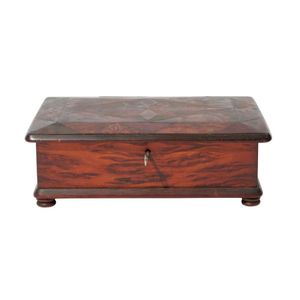19th Century New Zealand Specimen Wood Box by William Norrie
A New Zealand specimen wood box by William Norrie, late 19th century, rectangular, the slightly cushioned cover geometrically-veneered in various New Zealand woods including burr totara, rewa rewa, puriri, rata, and mottled kauri above the sides in mottled kauri with through dovetail joints and a base moulding, on turned feet, the carcase kauri, accompanied by an original W. Norrie trade card with a pencil diagram to the reverse indicating the woods used, 10.5 cm high, 31 cm wide, 20 cm deep. Provenance: The Estate of a late Toorak gentleman
You must be a subscriber, and be logged in to view price and dealer details.
Subscribe Now to view actual auction price for this item
When you subscribe, you have the option of setting the currency in which to display prices to $Au, $US, $NZ or Stg.
This item has been sold, and the description, image and price are for reference purposes only.
- Burr - Burr (or in the USA, burl) is the timber from the knotted roots or deformed branch of the tree, which when cut, displays the small circular knots in various gradations of colour. It is always cut into a decorative veneer, most commonly seen as burr walnut on 19th century furniture.
- Kauri - An evergreen conifer tree associated with New Zealand, but also grown in northern Australia, and islands around the Pacific rim including Borneo, Vanuatu and New Guinea. The timber is generally golden in colour, and straight grained without much knotting.
A by-product of the kauri tree was the kauri gum, the fossilised resin extracted from the tree. The gum was obtained through digging, fossicking in treetops, or more drastically, by bleeding live trees. Kauri gum was used in the manufacture of varnishes and other resin-based products, and also crafted into jewellery, keepsakes, and small decorative items.
Kauri forests were prolific in the north of the North Island of New Zealand. European settlers in the 1700 and 1800s realised that the timber from these tall trees with broad trunks would be ideal for ship building and construction and a thriving industry was established harvesting the kauri tree. The forests were substantially reduced, and now the remaining Kauri trees that grow in New Zealand are protected, and there are reserves in various areas of the North Island.
The remaining stands of kauri in New Zealand are under threat from "kauri disease", a microscopic organism that causes dieback in the trees, with vast tracts either dead or dying.
This item has been included into following indexes:
- boxes, material or decoration
- Norrie, William (New Zealand) - furniture and decorative items 38
- playing card boxes - wooden 14
- small wooden items - New Zealand 104
